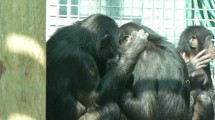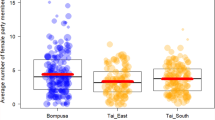Abstract
Based on previous research in captivity, bonobos, Pan paniscus, have been called a female-bonded species. However, genetic and behavioural data indicate that wild females migrate. Bonding between these unrelated females would then be in contradiction with socio-ecological models. It has been argued that female bonding has been overemphasized in captive bonobos. We examine patterns of proximity, grooming and support behaviour in six well established captive groups of bonobos. We find that female bonding was not a typical characteristic of all captive bonobo groups. In only two groups there was a trend for females to prefer proximity with other females over association with males. We found no evidence that following or grooming between females was more frequent than between males and unrelated females or between males. Only in coalitions, females supported each other more than male–female or male–male dyads. We also investigated five mother–son pairs. Grooming was more frequent among mothers and sons than in any other dyad, but sons did not groom their mothers more than males groomed unrelated females. Mothers groomed their sons, or provided more support to them than females groomed or supported unrelated males. Thus, while bonds between females were clearly present, intersexual relations between males and either unrelated females or their mothers are of more, or equal importance.




Similar content being viewed by others
References
Altmann J (1974) Observational study of behavior: sampling methods. Behaviour 49:227–267
Badrian A, Badrian N (1984) Social organization of Pan paniscus in the Lomako Forest, Zaire. In: Susman RL (ed) The pygmy chimpanzee: evolutionary ecology and behavior. Plenum Press, New York, pp 325–346
Baker KC, Smuts BB (1994) Social relationships of female chimpanzees: diversity between captive social groups. In: Wrangham RW, McGrew WC, de Waal FBM, Heltne PG (eds) Chimpanzee cultures. Harvard University Press, Cambridge, pp 227–242
Boesch C, Hohmann G, Marchant LF (2002) Behavioural diversity in chimpanzees and bonobos. Cambridge University Press, Cambridge
Fruth B, Hohmann G, McGrew WC (1999) The Pan species. In: Dolhinow P, Fuentes A (eds) The nonhuman primates. Mayfield, London, pp 64–72
Furuichi T (1989) Social interactions and the life history of female Pan paniscus in Wamba, Zaire. Int J Primatol 10:173–197
Furuichi T (1997) Agonistic interactions and matrifocal dominance rank of wild bonobos (Pan paniscus) at Wamba. Folia Primatol 18:855–875
Furuichi T, Ihobe H (1994) Variation in male relationships in bonobos and chimpanzees. Behaviour 130:212–228
Furuichi T, Idani G, Ihobe H, Kuroda S, Kitamura K, Mori A, Enomoto T, Okayasu N, Hashimoto C, Kano T (1998) Population dynamics of wild bonobos (Pan paniscus) at Wamba. Int J Primatol 19:1029–1043
Gerloff U, Hartung B, Fruth B, Hohmann G, Tautz D (1999) Intracommunity relationships, dispersal pattern and paternity success in a wild living community of Bonobos (Pan paniscus) determined from DNA analysis of faecal samples. Proc R Soc Lond B 266:1189–1195
Hashimoto C, Furuichi T, Takenaka O (1996) Matrilineal kin relationship and social behavior of wild bonobos (Pan paniscus): sequencing the D-loop region of mitochondrial DNA. Primates 37:305–318
Hemelrijk CK, Ek A (1991) Reciprocity and interchange of grooming and ‘support’ in captive chimpanzees. Anim Behav 41:923–935
Hohmann G, Fruth B (2002) Dynamics in social organization of bonobos (Pan paniscus). In: Boesch C, Hohmann G, Marchant LF (eds) Behavioural diversity in chimpanzees and bonobos. Cambridge University Press, Cambridge, pp 138–150
Hohmann G, Fruth B (2003) Culture in bonobos? Between-species and within-species variation in behavior. Curr Anthropol 44:563–571
Hohmann G, Gerloff U, Fruth B (1999) Social bonds and genetic tests: kinship, association and affiliation in a community of bonobos (Pan paniscus). Behaviour 136:1219–1235
Idani G (1991) Social relationships between immigrant and resident bonobo (Pan paniscus) females at Wamba. Folia Primatol 57:83–95
Ihobe H (1992) Male–male relationships among wild bonobos (Pan paniscus) at Wamba, Republic of Zaire. Primates 33:163–179
Kano T (1982) The social group of pygmy chimpanzees (Pan paniscus) of Wamba. Primates 23:171–188
Kano T (1992) The last ape: pygmy chimpanzee behavior and ecology. Stanford University Press, Stanford
Kuroda S (1979) Grouping of pygmy chimpanzees. Primates 20:161–183
Kuroda S (1980) Social behavior of pygmy chimpanzees. Primates 21:181–197
Martin P, Bateson P (1993) Measuring behaviour: an introductory guide, 2nd edn. Cambridge University Press, Cambridge
Muroyama Y, Sugiyama Y (1994) Grooming relationships in two species of chimpanzees. In: Wrangham RW, McGrew WC, de Waal FBM, Heltne PG (eds) Chimpanzee cultures. Harvard University Press, Cambridge, pp 169–180
Parish AR (1994) Sex and food control in the “uncommon chimpanzee”: how bonobo females overcome a phylogenetic legacy of male dominance. Ethol Sociobiol 15:157–179
Parish AR (1996) Female relationships in bonobos (Pan paniscus). Hum Nat 7:61–96
Parish AR, de Waal FBM (2000) The other “closest living relative”: how bonobos (Pan paniscus) challenge traditional assumptions about females, dominance, intra- and intersexual interactions, and hominid evolution. Ann NY Acad Sci 907:97–113
Smuts BB, Cheney DL, Seyfarth RM, Wrangham RW, Strushaker TT (1987) Primate societies. The University of Chicago Press, Chicago
Stanford CB (1998) The social behavior of chimpanzees and bonobos. Curr Anthropol 39:399–420
Sterck EHM, Watts DP, van Schaik CP (1997) The evolution of female social relationships in nonhuman primates. Behav Ecol Sociobiol 41:291–309
Stevens J, Vervaecke H, Melens W, Huyghe M, De Ridder P, Van Elsacker L (2003) Much ado about bonobos: ten years of management and research at Planckendael Wild Animal Park, Belgium. In: Gilbert T C (ed) Proceedings of the fifth annual symposium on zoo research, 7–8 July 2003, Marwell. Marwell Zoological Park, pp 114–125
van Schaik CP (1989) The ecology of social relationships amongst female primates. In: Standen V, Foley RA (eds) Comparative socioecology: the behavioural ecology of humans and other mammals. Blackwell, Oxford, pp 195–218
Vervaecke H, De Vries H, Van Elsacker L (2000a) The pivotal role of rank in grooming and support behaviour in a captive group of bonobos (Pan paniscus). Behaviour 137:1463–1485
Vervaecke H, de Vries H, Van Elsacker L. (2000b) Function and distribution of coalitions in captive bonobos (Pan paniscus). Primates 41:249–265
Vervaecke H, Stevens J, Van Elsacker L (2003) Interfering with others: female–female reproductive competition in Pan paniscus. In: Jones CB (ed) Sexual selection and reproductive competition in primates: new perspectives and directions. American Society of Primatologists, Oklahoma, pp 1235–1246
de Waal FBM (1978) Exploitative and familiarity dependent support strategies in a colony of semi-free living chimpanzees. Behaviour 66:268–312
de Waal FBM (1994) Chimpanzee’s adaptive potential. In: Wrangham RW, McGrew WC, de Waal FBM, Heltne PG (eds) Chimpanzee cultures. Harvard University Press, Cambridge, pp 243–260
de Waal FBM (1995) Bonobo sex and society. Sci Am 272(3):58–64
Franz C (1999) Allogrooming behavior and grooming site preferences in captive bonobos (Pan paniscus): association with female dominance. Int J Primatol 20:525–546
White FJ (1988) Party composition and dynamics in Pan paniscus. Int J Primatol 9:179–193
White FJ (1991) Pygmy chimpanzee social organization: variation with party size and between study sites. Am J Primatol 25:203–214
Wrangham RW (1980) An ecological model of female-bonded primate groups. Behaviour 75:262–299
Acknowledgements
We are grateful to the directory and keepers of Planckendael Wild Animal Park (Belgium), Apenheul Primate Park (The Netherlands), Wuppertal Zoo (Germany) and Twycross Zoo (UK) for their help and interest in this study. This research was funded by a Ph.D. grant of the Institution for the Promotion of Innovation through Science and Technology in Flanders (IWT-Vlaanderen: grant number 3340). We thank the Flemish Government for structural support of the Centre for Research and Conservation of the Royal Zoological Society of Antwerp. We thank three anonymous reviewers for their helpful comments on an earlier version of this manuscript.
Author information
Authors and Affiliations
Corresponding author
About this article
Cite this article
Stevens, J.M.G., Vervaecke, H., De Vries, H. et al. Social structures in Pan paniscus: testing the female bonding hypothesis. Primates 47, 210–217 (2006). https://doi.org/10.1007/s10329-005-0177-1
Received:
Accepted:
Published:
Issue Date:
DOI: https://doi.org/10.1007/s10329-005-0177-1




